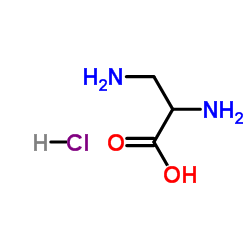DL-2,3-二氨基丙酸盐酸盐

DL-2,3-二氨基丙酸盐酸盐结构式

|
常用名 | DL-2,3-二氨基丙酸盐酸盐 | 英文名 | UNII:IU6ICR549L |
|---|---|---|---|---|
| CAS号 | 54897-59-5 | 分子量 | 140.569 | |
| 密度 | N/A | 沸点 | 325.6ºC at 760 mmHg | |
| 分子式 | C3H9ClN2O2 | 熔点 | 231-233 °C (dec.) | |
| MSDS | 美版 | 闪点 | 150.7ºC |
|
Discovery of Dap-3 polymyxin analogues for the treatment of multidrug-resistant Gram-negative nosocomial infections.
J. Med. Chem. 56(12) , 5079-93, (2013) We report novel polymyxin analogues with improved antibacterial in vitro potency against polymyxin resistant recent clinical isolates of Acinetobacter baumannii and Pseudomonas aeruginosa . In addition, a human renal cell in vitro assay (hRPTEC) was used to i... |
|
|
Capreomycin — A polypeptide antitubercular antibiotic with unusual binding properties toward copper(II)
J. Inorg. Biochem. 106(1) , 111-6, (2012) Capreomycin is an important therapeutic agent having intriguing and diverse molecular features. Its polypeptidic structure rich in nitrogen donors makes the drug a promising chelating agent for a number of transition metal ions, especially for copper(II). The... |
|
|
Synthesis of 9-membered dilactams derived from 1,3-diaminopropionic and glutamic acids.
J. Pept. Res. 63(3) , 235-40, (2004) Previously unknown 9-membered bridged dipeptides derived from l or d isomers of 1,3-diaminopropionic acids and l-glutamic acid were synthesized using aminoacyl incorporation reaction. Key intermediates containing internal pyroglutamyl moiety were prepared via... |
|
|
New 2,3-diaminopropionic acid inhibitors of AGE and ALE formation.
Org. Biomol. Chem. 11(5) , 773-80, (2013) Novel 2,3-diaminopropionic acid-based molecules were synthesised and tested successfully as glyoxal/methylglyoxal scavengers and as AGE inhibitors. Addition of an 8-hydroxyquinoline moiety led to an increase of the overall activity. The compounds tested in th... |
|
|
Incorporation of 2,3-diaminopropionic acid into linear cationic amphipathic peptides produces pH-sensitive vectors.
ChemBioChem. 11(9) , 1266-72, (2010) Nonviral vectors that harness the change in pH in endosomes, are increasingly being used to deliver cargoes, including nucleic acids, into mammalian cells. Here we present evidence that the pK(a) of the beta-NH(2) in 2,3-diaminopropionic acid (Dap) is suffici... |
|
|
Synthesis of a diaminopropanoic acid-based nucleoamino acid and assembly of cationic nucleopeptides for biomedical applications.
Amino Acids 43(6) , 2537-43, (2012) In this work, we report a synthetic approach to a Fmoc-protected nucleoamino acid, based on L-diaminopropanoic acid, carrying the DNA nucleobase on the alpha-amino group by means of an amide bond, suitable for the solid-phase synthesis of novel nucleopeptides... |
|
|
A conventional route for the synthesis of new oxazolidin-2-one derivatives with beta-aminoalanines.
Chem. Pharm. Bull. 52(10) , 1238-41, (2004) A conventional new route to the novel oxazolidin-2-one derivatives (3a-f) having two substituents on N-3 and C-4 in the oxazolidin-2-one ring was established with racemic beta-aminoalanine derivatives (1) as the key starting materials. |
|
|
Functional analysis of the genes encoding diaminopropionate ammonia lyase in Escherichia coli and Salmonella enterica serovar Typhimurium.
J. Bacteriol. 194(20) , 5604-12, (2012) Diaminopropionate ammonia lyase (DAPAL) is a pyridoxal-5'phosphate (PLP)-dependent enzyme that catalyzes the conversion of diaminopropionate (DAP) to pyruvate and ammonia and plays an important role in cell metabolism. We have investigated the role of the yge... |
|
|
Structure-activity relationship (SAR) of the α-amino acid residue of potent tetrahydroisoquinoline (THIQ)-derived LFA-1/ICAM-1 antagonists.
Bioorg. Med. Chem. Lett. 21(1) , 307-10, (2011) This letter describes the structure-activity relationship (SAR) of the 'right-wing' α-amino acid residue of potent tetrahydroisoquinoline (THIQ)-derived LFA-1/ICAM-1 antagonists. Novel (S)-substituted heteroaryl-bearing α-amino acids have been identified as r... |
|
|
Evaluation of [99mTc-(CO)3-X-Y-Bombesin(7-14)NH2] conjugates for targeting gastrin-releasing peptide receptors overexpressed on breast carcinoma.
Anticancer Res. 30(1) , 19-30, (2010) Gastrin-releasing peptide (GRP) receptors are overexpressed on a variety of human carcinomas, including those of the breast. These receptors may be targeted with bombesin (BBN), which binds to GRP receptors with high affinity and specificity. The aim of this ... |